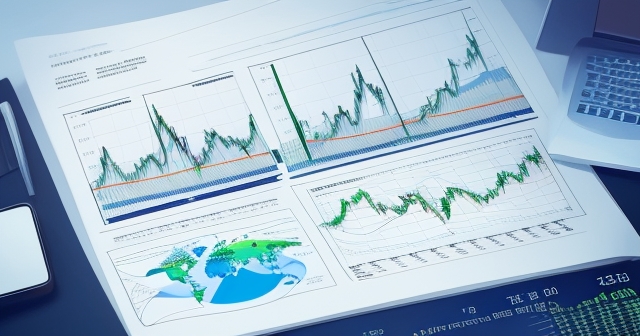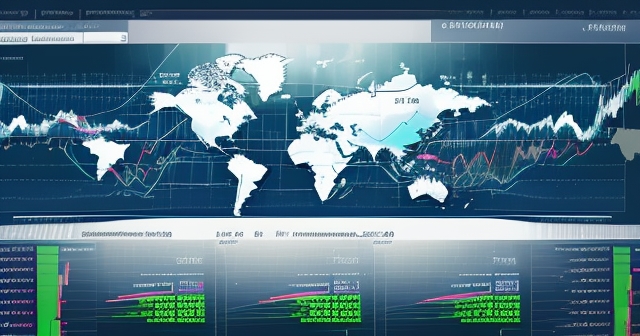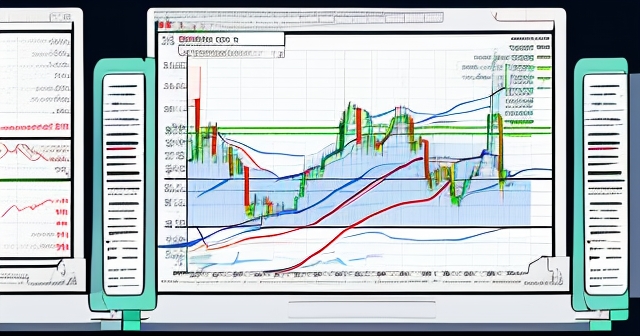Unlocking the Financial Ecosystem: A Deep Dive into Intermarket Analysis
Navigating the complexities of global financial markets can feel like trying to solve a puzzle where the pieces are constantly moving. You might be focused intently on the chart of a single stock or currency pair, analyzing its every flicker. But what if we told you that market movements rarely happen in isolation? That the price action you’re observing is often influenced, directly or indirectly, by what’s happening in entirely different corners of the financial world?
This interconnectedness is the core idea behind intermarket analysis. It’s a powerful approach that views financial markets not as separate entities, but as a vast, dynamic ecosystem where different asset classes – stocks, bonds, commodities, and currencies – are constantly interacting, influencing, and signaling to one another. Think of it like understanding the weather; you don’t just look at the temperature, you consider wind, humidity, pressure, and how they all combine to create the overall forecast. Similarly, successful market participants often look beyond a single market to grasp the broader financial climate.
- Intermarket analysis helps investors identify correlations among different asset classes.
- Understanding these relationships can lead to better trading strategies and risk management.
- Investors can use intermarket signals to confirm trading decisions and anticipate market movements.
Why does this matter to you, whether you’re a new investor finding your feet or an experienced trader honing your edge? Because by understanding these intermarket relationships, you gain a significantly more comprehensive view of market drivers. You can identify potential cause-and-effect chains, confirm analysis methods, generate broader trading ideas, and make more informed decisions that aren’t based on trading a market in isolation. It’s about seeing the forest, not just the trees, and recognizing how the health of the entire financial forest impacts the individual trees within it.

The Bedrock Relationship: Bonds and Interest Rates
At the heart of many intermarket relationships lies the bond market, specifically its connection to interest rates. This link is perhaps the most fundamental and widely understood. As you know, bond prices and interest rates have an inverse correlation. When interest rates rise, newly issued bonds offer higher yields, making older bonds with lower yields less attractive, thus causing their prices to fall. Conversely, when interest rates fall, existing bonds with higher yields become more appealing, driving their prices up.
Think about it from a simple yield perspective. If you can buy a new bond offering 5% interest, why would you pay full price for an old bond offering only 3%? You wouldn’t. The price of the old bond must drop until its effective yield (based on the lower price and fixed coupon payment) becomes competitive with the new higher rates. This inverse relationship is a cornerstone of fixed-income markets.
Now, how does this affect other markets? This is where intermarket analysis gets interesting. Rising interest rates make fixed-income investments like bonds more attractive relative to riskier assets like stocks. If you can get a decent, relatively safe return from bonds, the potential rewards from the stock market need to be higher to justify the increased risk. Therefore, rising bond yields (which reflect falling bond prices and/or expectations of higher future rates) are generally seen as a negative signal for the stock market. They represent increased competition for capital and often indicate tightening monetary conditions, which can dampen economic growth and corporate profits.
| Interest Rates | Effect on Bonds | Effect on Stocks |
|---|---|---|
| Rise | Decrease in bond prices | Negative signal for stocks |
| Fall | Increase in bond prices | Potentially positive signal for stocks |
Conversely, falling bond yields (rising bond prices) often suggest expectations of lower interest rates or a flight to safety, which can sometimes be supportive of stock valuations, especially if lower rates are seen as stimulating economic activity. However, a rapid drop in yields could also signal economic distress, prompting a different reaction in equities.

The Mighty Dollar and its Sway Over Commodities
Another critical relationship in the intermarket landscape is the dynamic between the US Dollar (USD) and commodities. Commodities like oil, gold, copper, and agricultural products are typically priced in US dollars on the global market. This pricing mechanism creates a strong inverse correlation between the value of the dollar and the price of commodities.
Here’s the logic: When the US dollar strengthens, it takes more of another currency to buy one dollar. For countries using those weaker currencies, buying dollar-denominated commodities becomes more expensive. This increased cost can dampen demand, leading to lower commodity prices. Conversely, when the US dollar weakens, it takes fewer units of other currencies to buy one dollar, making dollar-denominated commodities cheaper for international buyers. This can stimulate demand and push commodity prices higher.
Consider gold, often seen as a safe-haven asset. It has a well-known inverse correlation with the USD. When the dollar strengthens, gold typically weakens, and vice versa. This is partly due to the pricing mechanism and partly because gold is an alternative store of value to fiat currencies like the dollar. In times of economic uncertainty or when the dollar is perceived as losing value (perhaps due to inflation), investors may flock to gold, driving its price up while the dollar falls.

Oil prices also exhibit a significant inverse relationship with the USD, particularly impacting currency pairs involving major oil-exporting nations like Canada. The USD/CAD pair, for instance, is often negatively correlated with oil prices. When oil prices rise, Canada’s export revenues increase, strengthening the Canadian dollar (CAD) relative to the USD, causing USD/CAD to fall. When oil prices fall, the opposite tends to occur.
Understanding this USD-commodity link is vital. A strengthening dollar index might signal a need to decrease exposure to certain commodity markets or to the currencies of commodity-exporting countries. Conversely, a weakening dollar could present opportunities in those areas.
Interwoven Global Currencies and Equities
Beyond commodities, currency markets themselves are deeply intertwined with global equity markets and bond markets. Currency exchange rates are influenced by a multitude of factors, including interest rate differentials between countries, economic growth prospects, political stability, and capital flows.
Consider the link between bond yields and currencies. If a country’s central bank raises interest rates, its bond yields typically become higher relative to those in countries with lower rates. Higher yields can attract foreign investors seeking better returns on their fixed-income investments. To invest in those bonds, foreign investors must first buy the local currency, increasing demand for it and causing it to strengthen. This creates a positive correlation between a country’s bond yields and the value of its currency.
For example, Gold has shown positive correlations with currencies of commodity-producing countries like the AUD/USD and NZD/USD. As gold prices rise, the economies of Australia and New Zealand benefit from increased export revenue, strengthening their currencies against the USD. Similarly, rising oil prices tend to strengthen the Canadian dollar (CAD).
| Currency Pair | Correlation with Gold |
|---|---|
| AUD/USD | Positive |
| NZD/USD | Positive |
Global equity markets also exhibit significant correlations. The performance of major indices like the Dow Jones Industrial Average (Dow) in the U.S. and the Nikkei 225 in Japan are often correlated, reflecting the interconnectedness of the world’s largest economies. Movements in one can often signal potential moves in the other, although divergences can also provide powerful trading signals.
Furthermore, the Nikkei’s performance is often linked to the USD/JPY currency pair. A strengthening Japanese Yen (JPY) can be a negative for the Nikkei because it makes Japanese exports more expensive internationally. Conversely, a weaker Yen (higher USD/JPY) tends to be positive for the Nikkei as it boosts export competitiveness. This creates an inverse relationship between the Nikkei and the strength of the Yen (positive correlation with USD/JPY).
Understanding these currency-equity-bond linkages allows you to see how monetary policy decisions, economic data releases, or shifts in investor sentiment in one country can ripple across global markets.

Technical Tools for Quantifying Relationships
While understanding the *why* behind intermarket relationships is crucial, technical analysis provides tools to *quantify* and *visualize* these connections. These tools help us move beyond anecdotal observation to more objective assessment.
One primary tool is the correlation coefficient. This statistical measure ranges from +1 to -1. A coefficient of +1 indicates a perfect positive correlation (markets move in the same direction 100% of the time). A coefficient of -1 indicates a perfect inverse correlation (markets move in opposite directions 100% of the time). A coefficient near 0 suggests little to no linear relationship. Using correlation coefficients helps us see how strongly different markets are related over specific time periods.
Relative strength charts are also invaluable. Not to be confused with the Relative Strength Index (RSI), these charts compare the performance of one market or asset class against another. For instance, you could plot the ratio of the S&P 500 to the price of gold. A rising line suggests the S&P 500 is outperforming gold, indicating a potential risk-on environment (investors favoring stocks over safe havens). A falling line suggests gold is outperforming the S&P 500, potentially signaling risk aversion.
Overlay charts allow you to directly plot the price charts of two or more different markets on the same graph. This provides a visual way to spot correlations or divergences over time. While not quantifying the relationship as precisely as a coefficient, they offer a clear visual depiction of how markets are moving in tandem or diverging.
| Technical Tool | Description |
|---|---|
| Correlation Coefficient | Measures the strength of the relationship between markets. |
| Relative Strength Charts | Compares the performance of two assets over time. |
| Overlay Charts | Visual representation of the price movements of different markets. |
Other technical tools can be adapted for intermarket analysis. For example, applying moving averages or momentum oscillators to correlation coefficients themselves can help identify shifts in the *strength* or *direction* of relationships over time. Volatility indicators like the VIX (Volatility Index), which measures expected stock market volatility, can also be viewed through an intermarket lens; a rising VIX often correlates with falling stock prices and increasing demand for safe-haven assets like bonds or gold.
By combining conceptual understanding with these technical tools, you can gain a more robust view of the market’s underlying dynamics.
Fundamental Factors Driving Intermarket Connections
While technical tools quantify relationships, fundamental analysis explains *why* they exist and can signal when they might change. Fundamental factors are the underlying economic, political, and social forces that shape market behavior.
Interest rate analysis is paramount. Decisions by central banks (like the U.S. Federal Reserve, the European Central Bank, the Bank of Japan, etc.) on setting policy rates have profound effects that cascade through markets. Raising rates impacts bond yields, which affects stock valuations, currency strength, and even commodity demand (as higher borrowing costs can slow economic activity).
Economic indicators are another crucial component. Data releases like GDP growth, inflation rates (CPI, PPI), employment figures, retail sales, and manufacturing indices provide insights into the health and direction of an economy. Strong economic growth is generally positive for stocks (higher profits) but negative for bonds (potential inflation leading to higher rates). High inflation is negative for bond prices and can lead central banks to raise rates, impacting currencies and potentially slowing growth. Analyzing how these indicators are trending across major economies is vital for understanding intermarket flows.
| Economic Indicator | Impact on Markets |
|---|---|
| GDP Growth | Positive for stocks, negative for bonds |
| Inflation Rates | Negative for bonds, potential to raise rates |
Currency flows, capital flows, and international trade balances also play a significant role. Large movements of capital across borders in search of better returns or safety directly impact currency values and can signal shifts in global sentiment. For example, large inflows into U.S. Treasury bonds can strengthen the USD and lower U.S. yields, with intermarket consequences.
Analyzing commodity supply and demand dynamics, geopolitical events affecting specific regions or resources, and overall market sentiment (risk-on vs. risk-off) are also essential. A geopolitical crisis might boost oil prices, strengthen safe-haven currencies like the JPY or CHF, lead to a flight to safety in bonds, and cause a sell-off in stocks. This demonstrates how a single event can trigger a chain reaction across asset classes.
Integrating fundamental analysis with technical intermarket tools provides a powerful combination. Fundamentals help you understand the potential drivers of market movements, while technical analysis helps you time your entry and exit points based on observed price action and correlation strength.
Putting Intermarket Analysis to Work: Trading and Portfolio Management
How can you practically apply intermarket analysis in your own trading and investing? The insights gained from studying market relationships are highly actionable across various strategies.
Identifying potential market turning points is one key application. Often, one market will lead another. For example, bond markets can sometimes signal changes in economic expectations before equity markets react fully. If bond yields start to rise sharply, it might foreshadow future weakness in stocks as the market anticipates higher interest rates and slower growth.
Confirming trading signals is another use case. If you get a buy signal on a stock index based on your technical analysis, you might look at related markets for confirmation. Are bond yields falling? Is the dollar weakening? Are commodity prices rising? If intermarket signals align with your primary market signal, it can increase your confidence in the trade. Conversely, if intermarket signals contradict your primary signal, it might be a reason to pause or reconsider.

Generating broader trading ideas is also possible. If you see a clear trend developing in the bond market (e.g., yields are consistently rising), intermarket analysis suggests this trend might lead to opportunities in other markets, such as shorting stock indices or positioning for a stronger currency in countries with rising rates. If the dollar is breaking out, you might look for opportunities to short dollar-denominated commodities or go long currency pairs where the other currency is expected to weaken more or less than the dollar.
For those interested in currency trading specifically, understanding intermarket dynamics is paramount. Currency pairs don’t trade in a vacuum; their movements are a reflection of relative economic health, interest rate expectations, commodity prices, and capital flows between the two countries. For example, if you are considering a trade on EUR/USD, you would want to consider the relative strength of the Eurozone economy versus the U.S. economy, the interest rate policies of the ECB and the Fed, and how global risk sentiment is affecting flows into or out of the Euro and the Dollar.
If you’re considering starting currency trading or exploring more CFD products, then Moneta Markets is a platform worth considering. It is based in Australia and offers over 1000 financial instruments, suitable for both beginner and professional traders.
Intermarket Analysis in Portfolio Risk Assessment
Beyond finding trading opportunities, intermarket analysis is a powerful tool for risk assessment and portfolio management. Understanding how different assets are correlated helps you build a more robust and potentially less volatile portfolio.
Knowing the correlation coefficients between your portfolio’s assets allows you to assess diversification effectively. If you hold assets that are highly correlated, you are less diversified than if you hold assets with low or negative correlations. During times of market stress, correlations often increase (risk-on assets all fall together, safe havens all rise together), but understanding the typical relationships still provides a baseline for risk.
Monitoring intermarket relationships can also highlight potential vulnerabilities. For instance, if you have significant exposure to emerging market equities and you observe that commodity prices (which often correlate positively with emerging markets) are starting to fall sharply alongside a strengthening U.S. dollar, this confluence of intermarket signals might indicate increased risk for your emerging market holdings, prompting you to consider reducing exposure or adding hedges.
| Risk Management Technique | Description |
|---|---|
| Correlation Assessment | Assesses portfolio diversification based on asset correlations. |
| Monitoring Vulnerabilities | Identifies risk based on intermarket signals. |
Tracking correlation breakdowns is another critical risk management technique. While relationships tend to hold over time, they can occasionally break down. A breakdown might signal a significant shift in market dynamics or a potential warning sign. For example, if bond yields are rising, but stocks are also rising sharply (breaking the typical inverse correlation), it could signal excessive speculative behavior or a unique economic situation that requires deeper investigation.
Applying intermarket analysis to portfolio allocation involves making strategic decisions based on observed cross-market signals. For example, if bond yields are trending upward, a portfolio manager might consider reducing equity exposure or rotating into more defensive sectors that are less sensitive to interest rate changes. If the dollar index is showing significant strength, they might decrease exposure to commodities or the currencies of commodity-producing countries.
In essence, intermarket analysis provides a framework for constantly evaluating the relationships between your holdings and the broader market environment, helping you anticipate potential risks and make proactive adjustments.
Challenges and Nuances in Intermarket Analysis
While incredibly valuable, intermarket analysis is not without its challenges. Market relationships are not static; they are dynamic and can change over time depending on the prevailing economic climate, central bank policies, and market sentiment. A correlation that held strongly for years might weaken or even reverse in a different environment.
One challenge is obtaining reliable, timely, and consistent data quality across different markets and asset classes. Ensuring the data is accurate and comparable is essential for calculating meaningful correlations and analyzing relationships.
The sheer complexity of the global financial system means there are countless relationships at play, not just the core ones discussed here. Trying to track and understand every potential link can be overwhelming. It is often more practical to focus on the most historically significant and theoretically sound relationships relevant to the markets you trade or invest in.
Furthermore, correlation does not equal causation. While intermarket analysis looks for cause-and-effect, it’s important to remember that a strong correlation between two markets doesn’t definitively prove that one is causing the other to move. There might be an underlying third factor influencing both. Careful analysis and critical thinking are always required.
Finally, while we can identify historical relationships, predicting how they will behave in the future, especially during unprecedented events, remains challenging. The art of intermarket analysis lies in understanding the probabilities and using the relationships as guides, rather than rigid rules.
In choosing a trading platform, Moneta Markets‘ flexibility and technical advantages are worth noting. It supports popular platforms like MT4, MT5, and Pro Trader, combining high-speed execution with competitive low spread settings, offering a good trading experience.
The Evolving Landscape and Future of Intermarket Insights
The financial landscape is constantly evolving, driven by technological advancements, changing global power dynamics, and shifts in economic paradigms. Intermarket analysis must also evolve to remain relevant.
The rise of new asset classes, such as cryptocurrencies, introduces new potential relationships to consider. How do cryptocurrencies correlate with traditional safe havens like gold or fiat currencies? How does institutional adoption of digital assets impact capital flows and existing market dynamics? These are questions that intermarket analysts are beginning to explore.
The increasing speed of information dissemination and algorithmic trading also means that market reactions to intermarket signals can be faster and more complex than ever before. Understanding how these factors influence the timing and strength of correlations is becoming increasingly important.
Furthermore, events like pandemics or significant geopolitical conflicts highlight how non-traditional factors can temporarily disrupt or fundamentally alter established market relationships. The flight to safety during the early stages of the COVID-19 pandemic, for example, saw unusual correlations emerge as investors reacted to unprecedented uncertainty.
Despite these complexities, the fundamental principle of interconnectedness remains. Capital flows globally, economic health influences investment decisions, and risk appetite shifts across asset classes. Intermarket analysis provides a lens through which to view these forces, helping us make sense of the intricate web of global finance.
Bringing It All Together: A Holistic Market View
Intermarket analysis is not a standalone trading system, but rather a valuable framework and set of tools that enhances virtually any trading or investment approach. By understanding the intricate web connecting stocks, bonds, commodities, and currencies, you gain a more robust, informed, and potentially profitable perspective.
We’ve seen how the inverse dance between bonds and interest rates sets a baseline for the cost of capital and investor risk appetite. We’ve explored the dollar’s heavy hand on global commodity prices and the ripple effects on commodity-sensitive currencies. We’ve touched upon the interconnectedness of global equity markets and how yield differentials drive currency flows.
Using tools like correlation coefficients and relative strength charts allows us to quantify these relationships, while integrating fundamental analysis – central bank policy, economic data, geopolitical events – helps us understand the underlying drivers and anticipate potential shifts. Applying these insights informs everything from generating specific trading ideas and confirming signals to managing portfolio risk and making strategic allocation decisions.
While the relationships are dynamic and require continuous learning and adaptation, the core principles of intermarket analysis provide a timeless advantage. By viewing markets as an integrated ecosystem, you move beyond the limitations of analyzing assets in isolation. You are better equipped to understand the cause-and-effect chains, anticipate broader market movements, identify divergences, and ultimately, navigate the financial markets with greater confidence and insight.
If you are looking for a regulated broker that enables global trading, Moneta Markets holds multi-country regulatory certifications such as FSCA, ASIC, and FSA. It also provides a complete package including segregated client funds, free VPS, and 24/7 Chinese customer support, making it a top choice for many traders.
Embracing intermarket analysis means committing to seeing the bigger picture. It’s an ongoing journey of observation, analysis, and learning, but one that offers profound rewards in deepening your understanding of how the financial world truly works. By adding this powerful dimension to your analysis, you are better positioned to spot opportunities, manage risks, and potentially achieve your financial goals.
intermarket analysisFAQ
Q:What is intermarket analysis?
A:Intermarket analysis is the study of how different financial markets impact each other, providing insights into overall market trends.
Q:How can intermarket analysis improve trading strategies?
A:By understanding correlations between asset classes, traders can make better-informed decisions and anticipate market movements more accurately.
Q:What are some key tools used in intermarket analysis?
A:Tools include correlation coefficients, relative strength charts, and overlay charts to visualize and quantify market relationships.
